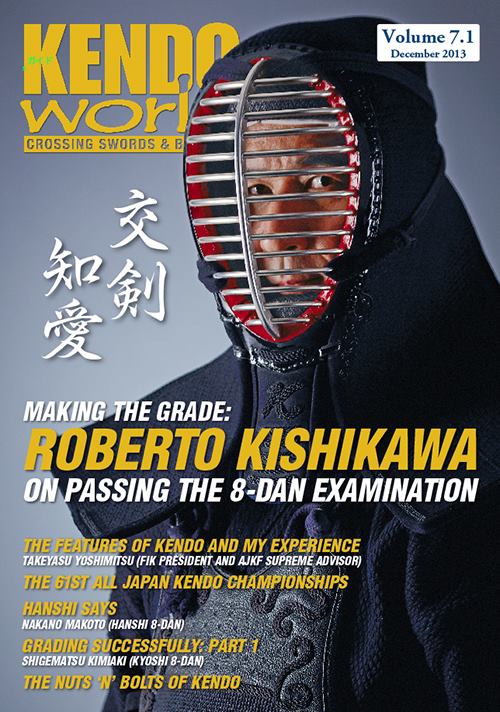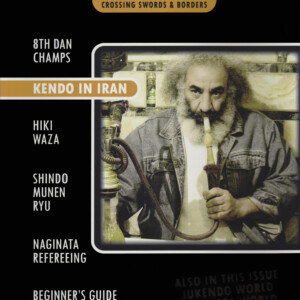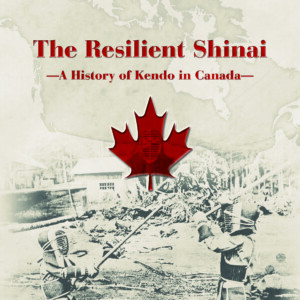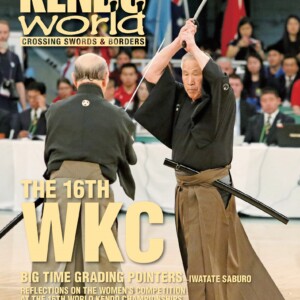
Kendo World 7.1

Editorial
By Alex Bennett
Alex Bennett reminisces on the Kendo World’s journey from its first to this, its 25th edition. He then goes on to discuss recent changes to attitudes in Japan in budo and kendo with regards to harsh training regimens.
The Features of Kendo and My Experience
By Takeyasu Yoshimitsu
Takeyasu-sensei was until recently president of the All Japan Kendo Federation. He has since retired from that position but acts as the supreme advisor to the AJKF as well as president of the International Kendo Federation. In this article Takeyasu-sensei gives his congratulations to Kendo World on reaching its 25th edition, discusses the development of kendo and his 80 years of kendo experience.
Making the grade: Roberto Kishikawa on passing the 8-dan examination
Interview by Dr. Stephen R. Nagy
November 27, 2013, marks an important date for kendoka around the world. That early evening, Roberto Kishikawa, a Brazilian national and permanent resident of Hong Kong, was promoted to 8-dan by the All Japan Kendo Federation (AJKF). As the first, non-Japanese kendoka to pass the 8-dan grading in Japan, Kishikawa-sensei has excited and inspired the overseas kendo community to strive for the highest levels of kendo. This article is an interview with Kishikawa-sensei concerning his exam experience, views on kendo and journey to 8-dan.
The 61st All Japan Kendo Championships
By Michael Ishimatsu-Prime
A summary and thoughts on the 61st All Japan Kendo Championships which Tokyo’s Uchimura Ryōichi won for the third time.
Hanshi Says
Hanshi Says is a popular series in which Japan’s top Hanshi teachers give hints of what they are looking for in grading examinations based on wisdom accumulated through decades of training. This issue features Nakano Makoto-sensei from Ibaraki prefecture who passed the 8-dan examination in 1979, and was awarded the title of Hanshi in 1989. Nakano-sensei asserts that in order to pass grading examinations, examinees need to make the examiners lean forward in their seats. He also discusses the importance of striking opportunities and the how kiri-kaeshi and uchikomi are a neccessity.
Grading Successfully: Part 1
By K8-dan Shigematsu Kimiaki-sensei
In “Grading Successfully Part 1”, Shigematsu Kimiaki-sensei, a kendo instructor with Chiba Prefectural Police Force, gives a detailed explanation of how to approach a grading. He covers a vast array of topics such as sonkyo, seme, hassei, datotsu, waza selection, and many more. This is an essential guide for those who are about to take a grading, particularly for the higher dan levels.
Nuts ‛n’ Bolts of Kendo: Effective Training Methods – Waza Training
By Nakano Yasoji (Hanshi 9-dan)
In this article, Nakano-sensei discusses the different types of keiko and how they should be carried out, as well as different types of waza and ideal situations in which they should be employed.
“Why am I alive?”
By Hamish Robison
This is the first part in a series of articles on Ogawa Chūtarō (1901-1992), one of the great kendoka of the post-war era.
Reidan Jichi: Kihon Dōsa – Part 5
By Ōya Minoru (Kendo Kyōshi 7-dan)
Kihon-dōsa, or basic movements, refers to kamae, footwork and manipulation of the shinai. In other words, it entails all of the principles behind the striking and thrusting movements for scoring yūkō-datosu (valid attacks) in kendo. This article looks at the four basic techniques of men, kote, dō and tsuki in detail.
Unlocking Japan Part 25: Oh the Shame
By Lockie Jackson
The final entry in Lockie Jackson’s column finishes with an account of witnessing a yakuza throwing his weight around and the feelings of shame that followed.
sWords of Wisdom: “Mumyō wo kiru” (Sever ignorance)
By Alex Bennett
This instalment is about the Tōgun-ryū, founded by Kawasaki Ginosuke. The philosophical basis of this school lies in the the teaching “mumyō wo kiru”. Mumyō is originally a buddhist term which refers to a state of “ignorance” or “darkness”. It is “Avidyā” or a “misunderstanding of the nature of reality; more specifically–a misunderstanding or misperception of the nature of the self and of phenomena.” So to “sever” the ignorance away is to remove all uncertainty. Darkness blinds the swordsman.
Bujutsu Jargon: Part 5
By Bruce Flanagan MA
Bruce continues his series introducing a number of terms often encountered by people interested in Japanese history and the martial arts.
Green Budo
By Manuela Hoflehner
The Austrian Kendo Association held the 2013 European Jodo Championships in Linz, Austria. Manuela Hoflehner reports on their efforts to decrease the championships’ environmental impact.
The 2nd World Combat Games
By Graham Sayer
The 2nd World Combat Games was held in St. Petersburg, Russia, in October 2013. Graham Sayer was there as a staff member and in this article he gives his lowdown on the event and the kendo competition.
Meiji Shrine Kobudō Demonstrations
By Jeff Broderick
Kendo World staff writer reports on the annual kobudō demonstrations that are held at Meiji Shrine in Tokyo on the same day as the All Japan Kendo Champioships, November 3. Here he introduces some of the different schools that demonstrated their techniques.
The 10th ASEAN Kendo Tournament – Taikai Report
By Blake Bennett
Kendo World’s Blake Bennett reports on the 10th ASEAN Kendo Tournament that was held in Penang, Malaysia, from august 23-25, 2013.
Looking at the History and Future of Japanese Women’s Kendo
By Ozawa Hiroshi (Translated by Kate Sylvester)
Ozawa Hiroshi-sensei (K8-dan) is author of Kendo: The Definitive Guide. Since April 2011 he has contributed a monthly article titled “Joshi Kendō no Rekishi to Kadai” (History and Issues of Women’s Kendo) to Gekkan Budō (Monthly Budō Magazine). This is a translation of “Looking into the History and Future of Japanese Women’s Kendo”, the 25th article in the series. It is a summary of the previous 24, and was published in the May 2013 issue of Gekkan Budō.
Kendo that Cultivates People: Part 15
By Sumi Masatake (Hanshi 8-dan)
“Teaching Kendo to the Next Generation” is the fifteenth part of the “Kendo that Cultivates People”. In this article, Sumi-sensei discusses how to recognise the objectives of kendo training through the act of teaching.
Book Mark: Geoff Salmon’s “Kendo, Inherited Wisdom and Personal Reflections”
By Michael Ishimatsu-Prime
Michael Ishimatsu-Prime reviews Geoff Salmon-sensei’s latest book, a collection of the most popular posts from his blog (www.kendo-info.net), which generally concentrates on the more esoteric, philosophical and cultural aspects of kendo and budo not found in technical manuals.
The Kendo Coach: Sports Psychology in Kendo: Part 10 — Series Summary
By Blake Bennett
Over the course of the past nine articles, the Kendo Coach series has aimed to highlight the importance of various psychological issues within the kendo dojo. From the first article titled “Developing a Psychological Skills Training (PST) Programme”, through to the fifth article titled “Team Cohesion and Goal Setting”, both the relevance and application of mental skills in kendo was addressed. Parts 6 through to 9 of the Kendo Coach series dealt with an equally important issue that requires the attention of kendo coaches in any and every dojo – that of violence and aggression. As a concluding piece to the Kendo Coach articles, part 10 will provide a brief “taster” of the entire series.
Tachikiri
By Jonathan Levine-Ogura
Every mid-January, when streets of snow canyons form in the hot spring city of Yuzawa, Akita Prefecture, in northern Japan, four male and two female competitors called motodachi compete in an event called tachikiri-jiai (立切試合). Possessing superb physical skills and mental strength developed over years of disciplined training, they participate in a marathon shiai event, lasting three hours for men and two for women, where they fight 33 and 22 opponents respectively, in succession, with no break. A regular visitor to this tournament and also a previous participant, Jonathon Levine-Ogura introduces this most gruelling of kendo shiai.
A Comparative Analysis of Bushido and Chivalry: Part 2
By Ryan McIntyre
What bushido and chivalry have most in common is that they are both fraught with misconception. Emerging as geologically distant, though philosophically similar equivalents, they were not static moral codes; rather, they were, and potentially still are, multifaceted, complicated and constantly changing social phenomena. Part Two of this essay will continue to attempt to trace the chronological origins of bushido and chivalry, identify and compare their core philosophies, investigate their development throughout history, and discuss the influence of these two systems on both medieval and modern society.
It’s Academic: Notes from the Japanese Academy of Budo
A list of the papers from the proceedings of the Japanese Academy of Budo’s 2013 International Budo Conference that was held at the University of Tsukuba from September 10-12, 2013. This is the latest research being conducted into budo.
Electromyographic patterns during kendo hiki-waza strikes in kendoka of different experience
By Yotani K., Maesaka S. – National Institute of Fitness and Sports in KANOYA
Muscle activity patterns in the arms during hiki-waza were assessed using electromyographic (EMG) analysis. Fourteen males (seven kendo athletes (kendoka) group; seven non-kendo (non-kendoka) athletes group) were asked to perform hiki-men (men) and hiki-kote (kote) strikes as quickly as possible with a shinai using the arms. EMG signals from the bilateral biceps brachii, bilateral triceps brachii and the right flexor carpi ulnaris muscles were recorded together with elbow joint angle and striking force. The results suggest that there is a difference in neuromuscular function for men and kote tasks between experienced and inexperienced kendoka groups.
Mario Bottoni’s Legacy
By Donatella Castelli
“Not many are familiar with the history of Italian Kendo. Some older European kenshi remember a rather tormented history of multiple federations, but nowadays, no one wonders why the Italian Kendo Renmei is called CIK (Italian Kendo Confederation), even though its current organisational structure does not resemble a confederation. In this article I wish to remember one of the protagonists in the history of Italian kendo: Mario Bottoni.”
Shinai Sagas: The Coil
By Charlie Kondek
Charlie Kondek’s Shinai Sagas continues: “When Takeo Murata bowed, it was with the grace of generations at his shoulders, and it looked very natural, a small, easy movement he had made thousands of times since childhood. The same movement, by Jeff Graham, still seemed stiff and unaligned after 20 years. But both men raised their shinai to the taito position at the hip with the same efficiency, and the observable differences between them dissolved when they squatted in sonkyo with the kensen of their weapons inches apart.”
Confusion regarding waza in beginner kendoka
By Thomas Sluyter
In order to better understand the various types of waza and what their differences and similarities are, Thomas Sluyter created a chart and Venn diagram that explains them.
Nito – Part 7: Practical Techniques
By Yamaguchi Masato
Yamaguchi Masato’s series on nitō kendo continues with a look at how to fight against various types of kamae with orthodox and gyaku-nitō
The Kote/Shoe Dryer
By Michael Ishimatsu-Prime
Michael’s wife, like those of many kendoka, has a problem with the smell of his kote. She decided to take matters into her own hands and bought him a shoe-dryer that can also be used to dry kote.
AVAILABLE IN PRINT AND KINDLE VERSIONS AND ON THE BUDO BOOKS APP IN E-BOOK FORMAT! SEE THE LINKS BELOW!!
























No comments yet.